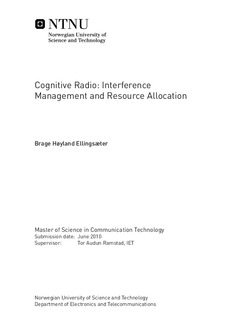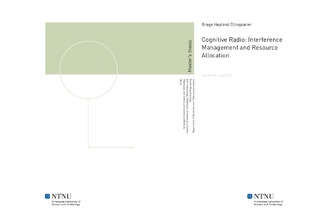| dc.contributor.advisor | Ramstad, Tor Audun | nb_NO |
| dc.contributor.author | Ellingsæter, Brage Høyland | nb_NO |
| dc.date.accessioned | 2014-12-19T13:46:03Z | |
| dc.date.accessioned | 2015-12-22T11:44:35Z | |
| dc.date.available | 2014-12-19T13:46:03Z | |
| dc.date.available | 2015-12-22T11:44:35Z | |
| dc.date.created | 2010-11-08 | nb_NO |
| dc.date.issued | 2010 | nb_NO |
| dc.identifier | 361277 | nb_NO |
| dc.identifier | ntnudaim:5599 | |
| dc.identifier.uri | http://hdl.handle.net/11250/2370088 | |
| dc.description.abstract | In this thesis the performance of different cognitive systems are analyzed in different environments and scenarios. The main scenarios are: one cognitive and one primary user, multiple cognitive users and channels and multiple cognitive and primary users. With primary users in the vicinity, cognitive systems are evaluated both when no degradation to primary user QoS is allowed and when some degradation is allowed, measured by an outage probability. In all scenarios involving one or more primary users, the performance is evaluated over two phases. In Phase 1 the channel is idle, i.e. the primary users are silent, and in Phase 2 the primary users are active on the channel. One of the questions in this thesis is how can cognitive users transmit simultaneously with the primary user in Phase 2. Schemes that show that this is possible is presented and evaluated and performance is compared to a standard cognitive system only transmitting when the channel is idle.In scenarios with multiple cognitive users and channels, power allocation schemes are reviewed. A novel power allocation algorithm presented in cite{burr}, called modified water filling in this thesis, is implemented and referenced against other well-known power allocation schemes.All implementation and simulations were done in MATLAB. It was assumed infinite processing power at all cognitive users, i.e. no processing delay, and perfect spectral sensing at all cognitive users. The results showed that the performance gain of cognitive system utilizing simultaneous transmission achieves only a slight performance gain over a standard cognitive system, when no degradation to primary user QoS is allowed. However, by allowing only a slight degradation in primary user QoS, the gain is significant and should be included in future work on cognitive radio as it shows a promising way to exploit spectra. | nb_NO |
| dc.language | eng | nb_NO |
| dc.publisher | Institutt for elektronikk og telekommunikasjon | nb_NO |
| dc.subject | ntnudaim:5599 | no_NO |
| dc.subject | SIE7 kommunikasjonsteknologi | |
| dc.subject | Signalbehandling og kommunikasjon | |
| dc.title | Cognitive Radio: Interference Management and Resource Allocation | nb_NO |
| dc.type | Master thesis | nb_NO |
| dc.source.pagenumber | 94 | nb_NO |
| dc.contributor.department | Norges teknisk-naturvitenskapelige universitet, Fakultet for informasjonsteknologi, matematikk og elektroteknikk, Institutt for elektronikk og telekommunikasjon | nb_NO |

